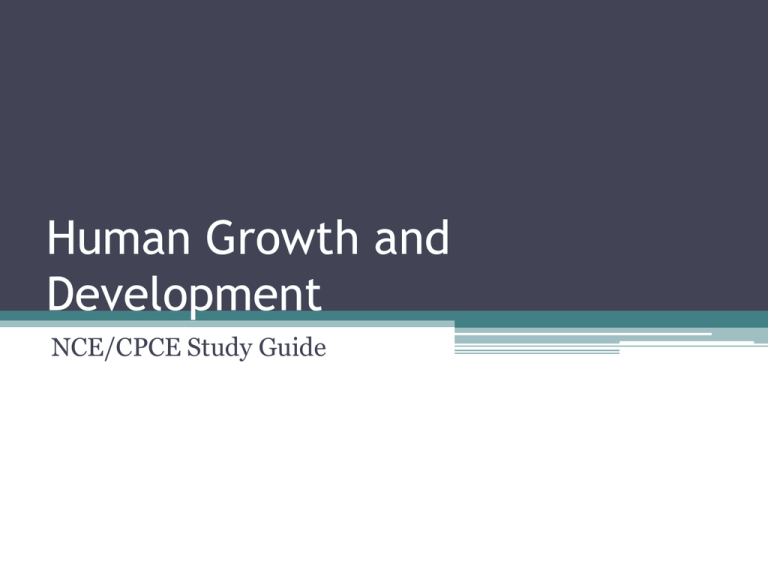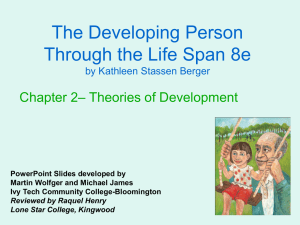
Human Growth and
Development
NCE/CPCE Study Guide
Foundational issues in HGD
A. Stages of human development
• Prenatal period (conception to birth)
• Infancy (birth to 2 yrs)
• Toddlerhood (2 -3 yrs)
• Early childhood (3 -5 yrs)
• Middle childhood (6-12yrs)
• Adolescence (13-19 yrs)
• Young adulthood (19 -30)
• Middle adulthood (30 -60)
• Late adulthood (60 – 75)
• Old age ( 75+)
Foundational issues in HGD
• B. Types of aging
• Biological aging (metabolic changes – anabolism
and catabolism)
• Psychological aging
• Social aging
Foundational issues in HGD
• C. Categorizing theories of human development
• Learning, cognitive, psychoanalytic, humanistic,
ethological, language, physical, and moral
development.
• Also: Nature vs nurture; continuous
development vs discontinuous development;
active vs reactive theories.
Special designs in HGD research
•
•
•
•
•
•
•
Case study
Naturalistic study
Survey research
Correlation research design
Cross-sectional design studies
Longitudinal design studies
Time-lag studies
Questions
•
•
•
•
•
1. Aging is
A. Biological
B. Social
C. Psychological
D. all of the above
Questions
• 2. Which of the following is NOT a true
statement about biological aging?
• A. Biological aging depends on metabolic
changes
• B. Biological aging refers to people’s perception
of how old or young they feel
• C. Biological aging refers to people’s perceptions
of how old or young they feel.
• D. Biological aging involves catabolism.
Questions
•
•
•
•
3. Catabolism refers to
A. the body’s decline to death from its peak.
B. the body’s development from birth to its peak.
C. the metabolic changes that occur in the
elderly
• D. none of the above
Questions
• 4. Intelligence is accounted for mostly by a
person’s
• A. environment
• B. genetics
• C. genetics and environment in equal parts
• D. educational level.
Questions
• 5. Epigenetic theorists emphasize the
importance of
• A. nature
• B. nurture
• C. the combination of nature and nurture
• None of the above.
The Central Nervous System (CNS)
• CNS – brain and spinal cord
• Peripheral nervous system – network of nerves
that connects the central nervous system to the
rest of the body
• Growth of the brain involves addition of new
neurons and interconnectedness of these
neurons and myelination (i.e. insulation of the
neurons to enhance speed of neural
transmissions).
The Brain
• Hindbrain – medulla oblongata; cerebellum;
pons; reticular activating system.
• Midbrain
• Forebrain – left hemisphere; right hemisphere;
corpus callosum; cerebral cortex.
• Other structures: thalamus; limbic system
(hypothalamus, the amygdala and hippocampus)
• Hemispheric specialization or lateralization
Genetic disorders
• Three major classes:
• 1. Autosomal diseases – genetic disorders that
involve a chromosome other than the sex
chromosome.
• 2. X-linked diseases – passed on by the maternal Xchromosome to males.
• 3. Sex chromosomal diseases – some genetic
anomaly occurring on the sex-determining pair of
chromosomes, usually affecting male or female
characteristic displays or sexual reproduction.
Questions
• 1. The brain usually reaches its adult weight by
the time a person is
• A. 12 years old
• B. 16 years old
• C. 44 years old
• D. 64 years old
Questions
•
•
•
•
•
2. The most primitive part of the brain is
A. hindbrain
B. midbrain
C. forebrain
D. Cerebral cortex
Questions
• 3. The ___________is responsible for
regulating arousal and attention.
• A. medulla oblongata
• B. cerebellum
• C. Reticular activating system
• D. Hypothalamus
Questions
•
•
•
•
•
4. Sickle cell anemia is
A. an X-linked disease
B. a sex chromosomal disorder
C. an autosomal disorder
D. none of the above
Questions
•
•
•
•
•
5. Males born with an extra X chromosome have
A. Turner syndrome
B. Tay-Sachs disease
C. phenylketonuria
Klinefelter’s syndrome
Learning theories
• Learning = a relatively permanent change in
behavior or thinking resulting from an
individual’s experiences.
• Learning theorists propose that individuals
observe and react to their environment.
• 1. Stimulus-response theories
• 2. Social learning theories
Classical conditioning
• Ivan Pavlov – salivating dogs
• John B. Watson - “father of American
behaviorism” – Little Albert
• Joseph Wolpe- systematic desensitization;
counterconditioning; aversive
counterconditioning; flooding.
Operant conditioning
• Edward Thorndike – Law of Effect
• B.F. Skinner – Operant conditioning – vast
majority of learning occurs when an individual
operates on the environment or when the
environment controls the contingencies of
reinforcement for the individual. Positive
reinforcement; negative reinforcement;
punishment; reinforcement schedules.
Social learning
• Albert Bandura
• People learn through observation, imitation, and
modeling.
• Self-efficacy – (term developed by Bandura) –
individual’s confidence in his or her ability to
perform a given behavior or accomplish a given
task.
The Dollard and Miller Approach
• John Dollard
• Neal Miller
• Influenced by the psychoanalytic, behavioral,
and social science concepts that preceded them.
• Anxiety and psychological disturbances were
learned from experiences.
The Dollard and Miller Approach
•
•
•
•
They identified three primary types of conflicts:
Approach- approach conflicts
Approach-avoidance conflicts
Avoidance-avoidance conflicts
Questions
• 1. In Ivan Pavlov’s famous experiments with
dogs, the conditioned stimulus was
• A. the salivation
• B. the meat powder
• C. the bell, buzzer, or tone.
• D. None of the above.
Questions
• 2. In classical conditioning, when people present
a conditioned stimulus at the same time as the
unconditioned stimulus, they are using
• A. Backward conditioning
• B. simultaneous conditioning
• C. retroactive conditioning
• D. delayed conditioning.
Questions
• 3. ________is the most successful form of
conditioning.
• A. Backward conditioning
• B. Simultaneous conditioning
• C. Retroactive conditioning
• D. Delayed conditioning
Questions
• 4. John B. Watson is most well-known for his
experiments involving
• A. a rat
• B. dogs
• C. ducklings
• D. cats
Questions
• _____________is best known for the theory
of operant conditioning.
• A. Ivan Pavlov
• B. B.F. Skinner
• C. John B. Watson
• D. Albert Bandura
Cognitive Development
• Jean Piaget’s cognitive development theory
• Growth in mental development depended on
one’s ability to order and classify new
information: organization
• Changes in cognitive structure occurred through
adaptation, which involved assimilation and
accommodation
• Schema
• Equilibrium
• 4 stages of cognitive development
Lev Vygotsky’s Cognitive Development
Theory
• Constructionist, cognitive developmental theory
that integrated language as well as social and
cultural influences.
• Cognitive progress facilitated by language
development and occurred in a social context.
• Zone of proximal development
• Scaffolding
• Described children’s speech during the first 3
years of life
Cognition and memory
• Sensory memory – all the environmental stimuli to
which one is exposed at any given moment in time.
This information is ordinarily retained form only a
few seconds.
• Short-term memory – temporary information
storage that allows information to be retained for
seconds to minutes.
• Long-term memory – enables a person to store a
large amount of information for relatively
permanent amounts of time, depending on how
efficiently the person learned the information.
Cognition and memory
•
•
•
•
•
•
Encode
Retrieval theory
Decay of memory theory
Interference theory
Retroactive inhibition
Proactive inhibition
Other important concepts in cognitive
development
•
•
•
•
•
•
•
Cognitive dissonance
Attribution theory
Imaginary audience (David Elkind)
Personal fable
Intelligence
Crystallized intelligencee
Creativity
Questions
• 1. According to Piaget, when people use their
existing cognitive framework to understand new
information, they are involved in the process of
adaptation, known as
• A. assimilation
• B. accommodation
• C. symbolic representation
• D. All of the above
Questions
• 2. Children learn object permanence in the
_________ stage of Piaget’s theory of cognitive
development.
• A. sensorimotor
• B. Preoperational
• C. concrete operational
• D. formal operational
Question
• 3. Animism refers to
• A. only being able to focus on one aspect of a
problem at a time
• B. thinking that humans created everything in
the world
• C. giving life to lifeless objects
• D. the belief that actions cannot be reversed.
Questions
• 4. Individuals can think logically and abstractly
when they reach the _______stage of Piaget’s
theory of cognitive development.
• A. sensorimotor
• B. preoperational
• C. concrete operational
• D. formal operational
Questions
• 5. Some teenagers drive over the speed limit
without wearing seatbelts because they do not
believe that they can be hurt. These teenagers
• A. have an imaginary audience
• B. have created a personal fable
• C. are engaged in magical thinking
• D. are using divergent thinking.
Questions
• Noam Chomsky’s theory of language
development is considered to be a(n):
• A. learning theory approach
• B. nativist approach
• C. interactionist approach
• D. epigenetic approach
Cont.
• Language rules that transcend specific languages
and cultures are called:
• A. surface structures
• B. global structures
• C. deep structures
• D. instrinsic structures
Cont.
• How many morphemes does the word “books”
have?
• A. 1
• B. 2
• C. 3
• D. 4
Cont.
• The appropriate use of grammar is the definition
of :
• A. Syntax
• B. Pragmatics
• C. Semantics
• D. Phonology
Cont.
•
•
•
•
•
When do babies become adept to holophrasing?
A. Approx. 8 months of age
B. Approx. 10 months of age
C. Approx. 1 year of age
D. Approx. 1.5 years of age
Personality Development
•
•
•
•
•
Freud believed that fixation results from:
A. overgratification
B. undergratification
C. Both overgratification and undergratification
D. None of the above
Cont.
• Erikson would consider a normal 4-year-old
child to be in the ____________stage of
personality development.
• A. Initiative vs Guilt
• B. Basic trust vs. mistrust
• C. Autonomy vs. Shame and Doubt
• D. Industry vs. Inferiority
Cont.
• A person who obeys group rules and seeks
familial acceptance is in the ________stage of
Loevinger’s ego development theory.
• A. Integrated
• B. Conformist
• C. Self-awareness
• D. Conscientious
Cont.
• According to Maslow, before people can meet
their needs for esteem, they must meet their
need for:
• A. Safety
• B. Belongingness
• C. Survival (Physiological needs)
• D. All of the above
Cont.
• Children who are clingy and react strongly to
separation from their caregivers are considered
by Mary Ainsworth to display:
• A. secure attachment
• B. Avoidant attachment
• C. Ambivalent attachment
• D. Disorganized attachment









